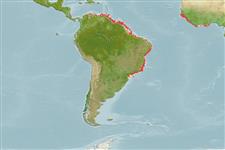Common names from other countries
Environment: milieu / climate zone / depth range / distribution range
Ecologia
; intervalo de profundidade 0 - 30 m (Ref. 83435). Tropical; 12°N - 28°S, 62°E - 0°E (Ref. 83435)
Atlantic Ocean: Trinidad and Tobago to Brazil, and tropical West Africa.
Length at first maturity / Tamanho / Peso / Idade
Maturity: Lm ? range ? - ? cm Max length : 16.6 cm DL macho/indeterminado; (Ref. 83435); common length : 16.0 cm TL macho/indeterminado; (Ref. 355)
Shell fusiform, spire high, anterior canal well developed, shell surface with sculpture of many fine spiral threads. Shoulder angular, with single row or nodules. Periostracum thick and hairy. Colour: chocolate brown to black, with a few contrasting white bands, periostracum brownish.
Lives on mud and other soft substrates in mangrove areas and near river estuaries. Feeds mainly on carrion (Ref. 355).
Life cycle and mating behavior
Maturidade | Reprodução | Desova | Ovos | Fecundidade | Larvas
This species is a non-broadcast spawner. Life cycle does not include trocophore stage. Also Ref. 833.
Leal, J.H. 2003. (Ref. 355)
Categoria na Lista Vermelha da IUCN (Ref. 130435)
Categoria CITES (Ref. 108899)
Not Evaluated
Not Evaluated
Ameaça para o homem
Harmless
Utilização humana
| FishSource |
Ferramentas
Mais informação
Idade/TamanhoCrescimentoComprimento-pesoComprimento-comprimentoMorfologiaLarvasAbundância
Fontes da internet
Estimates based on models
Preferred temperature
(Ref.
115969): 26.7 - 28.3, mean 27.5 (based on 255 cells).
Categoria de preço
Unknown.
